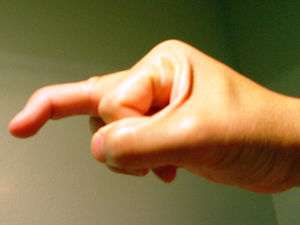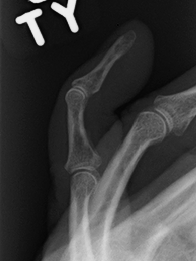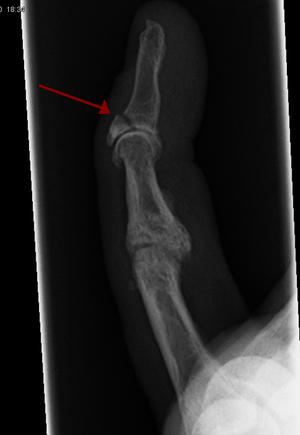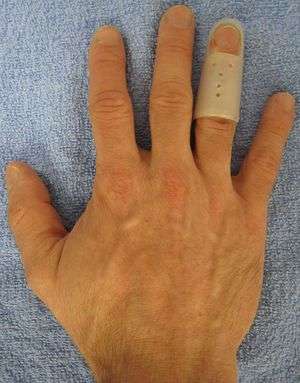Mallet finger
Background
- Rupture of extensor tendon in area of distal phalanx distal to DIP joint
- May be accompanied by avulsion fracture
- Caused by forced flexion of extended DIP joint
- If untreated, leads to swan neck deformity

Finger in maximum extension

Mallet finger without fracture

Mallet finger with fracture at the insertion of the extensor tendon
Clinical Features
- DIP joint flexed to 40°, unable to fully extend
Differential Diagnosis
Hand and finger injuries
- Distal finger
- Other finger/thumb
- Boutonniere deformity
- Mallet finger
- Jammed finger
- Jersey finger
- Trigger finger
- Ring avulsion injury
- De Quervain tenosynovitis
- Infiltrative tenosynovitis
- Metacarpophalangeal ulnar ligament rupture (Gamekeeper's thumb)
- Hand
- Wrist
- Drummer's wrist
- Ganglion cyst
- Lunotriquetral ligament instability
- Scaphoid fracture
- Extensor digitorum tenosynovitis
- Compressive neuropathy ("bracelet syndrome")
- Intersection syndrome
- Snapping Extensor Carpi Ulnaris
- Vaughn Jackson syndrome
- General
Evaluation
- Clinical diagnosis
- Consider finger x-ray (PA and lateral) to evaluate for avulsion fracture
Management
- Splint DIP joint in continuous slight hyperextension x 6 wk
- Splinting of the PIP joint is not necessary and should be avoided[1]
- Inadvertently splinting PIP for 6 weeks results in collateral ligamentous overgrowth and functional disability[2]
- Give an extra splint

Special Mallet finger splint (if available)
Disposition
- Discharge with hand surgery follow-up in 7-10 days
See Also
References
- Katzman B et al. Immobilization of the mallet finger: effects of the extensor tendon. J Hand Surg Br. 1992; 24(1):80-84
- Prosser R. Splinting in the management of proximal interphalangeal joint flexion contracture. J Hand Ther. 1996 Oct-Dec;9(4):378-86.
This article is issued from
Wikem.
The text is licensed under Creative
Commons - Attribution - Sharealike.
Additional terms may apply for the media files.